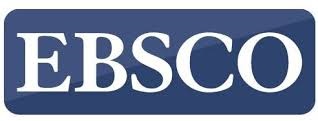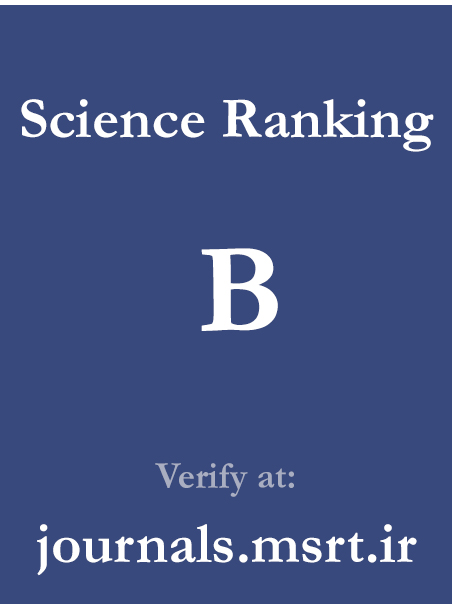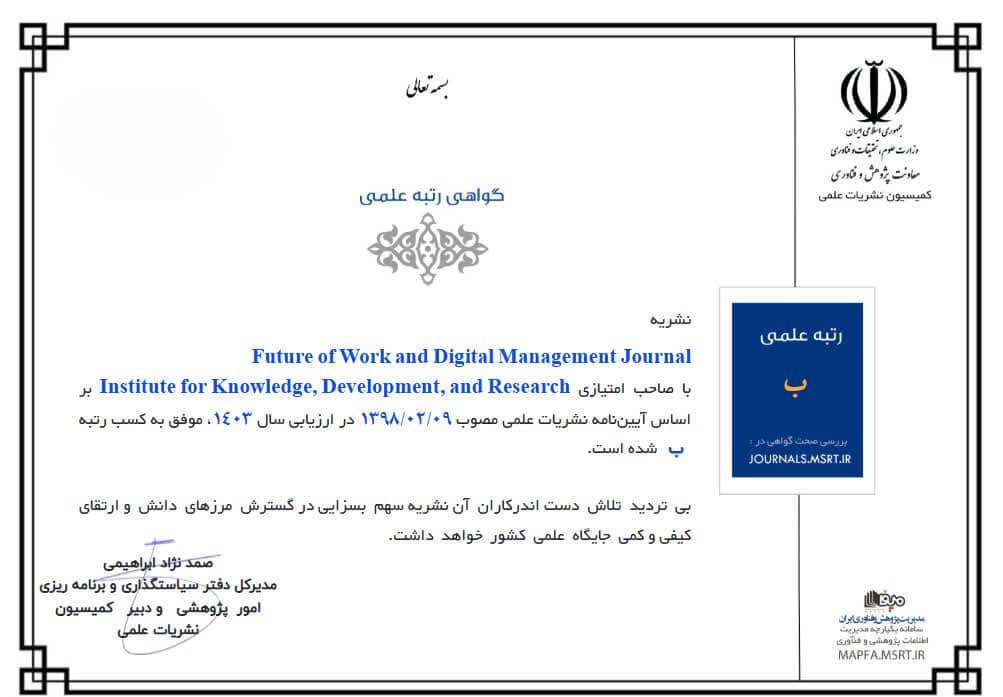Providing a Model for Implementing an Effective Internal Control System in Banks
Keywords:
internal control implementation, bank, COSO, COBITAbstract
The purpose of this research was to propose a model for implementing an effective internal control system in banks. Accordingly, from the perspective of its objective, this is an applied study, because in addition to its informative and scientific aspects, it also has practical implications for various companies and organizations, especially banks. Considering the purpose and nature of the study, the research method is qualitative. Furthermore, since this research aims to design a model, it is exploratory in nature. The results showed that the final factors identified after the thematic analysis and data analysis stage include: organizational and structural barriers (deficiency in organizational structure, shortage of organizational resources, and weak organizational culture), legal and regulatory barriers (deficiency in laws and regulations, supervisory challenges, and compliance issues), technological and informational barriers (deficiency in technology infrastructure, information management challenges, and automation issues), human and skill-related barriers (lack of skills and knowledge, deficiency in training and development, and motivational and behavioral issues), process and operational barriers (deficiency in process design, implementation challenges, and supervision and control issues), and environmental and external barriers (economic impacts, competitive challenges, and technological and innovation influences).
Downloads
References
[1] S. Ahmad, R. Karim, N. Sultana, and R. P. Lima, "InsurTech: Digital Transformation of the Insurance Industry," in Financial Landscape Transformation: Technological Disruptions: Emerald Publishing Limited, 2025, pp. 287-299.
[2] S. Cosma and G. Rimo, "Redefining insurance through technology: Achievements and perspectives in InsurTech," Research in International Business and Finance, 2024, doi: 10.1016/j.ribaf.2024.102301.
[3] K. Balaji and E. Ariwa, "Insurtech disruption: Reshaping the future of insurance in the fintech era," in The Adoption of FintechPB - Productivity Press, 2024, pp. 247-266.
[4] J. Liu, Ye, Shujun, Zhang, Yujin, Zhang, Lulu, "Research on InsurTech and the technology innovation level of insurance enterprises," Sustainability, vol. 15, no. 11, p. 8617, 2023. [Online]. Available: https://www.mdpi.com/2071-1050/15/11/8617.
[5] P. Kumar, S. Taneja, E. Özen, and S. Singh, "Artificial Intelligence and Machine Learning in Insurance: A Bibliometric Analysis," pp. 191-202, 2023, doi: 10.1108/S1569-37592023000110A010.
[6] K. I. Jones and S. Sah, "The Implementation of Machine Learning In The Insurance Industry With Big Data Analytics," International Journal of Data Informatics and Intelligent Computing, vol. 2, no. 2, pp. 21-38, 2023, doi: 10.59461/ijdiic.v2i2.47.
[7] V. Gatteschi, F. Lamberti, C. Demartini, C. Pranteda, and V. Santamaría, "Blockchain and smart contracts for insurance: Is the technology mature enough?," Future Internet, vol. 10, no. 2, p. 20, 2018, doi: 10.3390/fi10020020.
[8] A. J. Pagano, F. Romagnoli, and E. Vannucci, "Implementation of blockchain technology in insurance contracts against natural hazards: a methodological multi-disciplinary approach," Environmental and Climate Technologies, vol. 23, no. 3, pp. 211-229, 2019, doi: 10.2478/rtuect-2019-0091.
[9] H. Dutta, S. Nagesh, J. Talluri, and P. Bhaumik, "A solution to blockchain smart contract based parametric transport and logistics insurance," IEEE Transactions on Services Computing, vol. 16, no. 5, pp. 3155-3167, 2023, doi: 10.1109/TSC.2023.3281516.
[10] A. Rachad, L. Gaiz, K. Bouragba, and M. Ouzzif, "A Smart Contract Architecture Framework for Insurance Industry Using Blockchain and Business Process Management Technology," IEEE Engineering Management Review, 2024, doi: 10.1109/EMR.2023.3348431.
[11] A. Farao, G. Paparis, S. Panda, E. Panaousis, A. Zarras, and C. Xenakis, "INCHAIN: a cyber insurance architecture with smart contracts and self-sovereign identity on top of blockchain," International Journal of Information Security, vol. 23, no. 1, pp. 347-371, 2024, doi: 10.1007/s10207-023-00741-8.
[12] L. D. Sotiropoulos, "Addressing Smart Contracts in the Insurance Sector: Institutional Framework and Practical Aspects," ENTHA, vol. 20, p. 22, 2023. [Online]. Available: https://heinonline.org/hol-cgi-bin/get_pdf.cgi?handle=hein.journals/entha20§ion=9.
[13] S. Koduru, P. Reddy, and P. Padala, "Integrated disaster management and smart insurance using cloud and internet of things," International Journal of Engineering & Technology, vol. 7, no. 2.6, pp. 241-246, 2018, doi: 10.14419/ijet.v7i2.6.10777.
[14] C. B. Santoso, H. Prabowo, H. L. H. S. Warnars, and A. N. Fajar, "Smart Insurance System Model Concept for Marine Cargo Business," in 2021 International Conference on Data Science and Its Applications (ICoDSA), 2021, pp. 281-286, doi: 10.1109/ICoDSA53588.2021.9617499.
[15] K. L. Narayanan, C. R. S. Ram, M. Subramanian, R. S. Krishnan, and Y. H. Robinson, "IoT based smart accident detection & insurance claiming system," in 2021 Third international conference on intelligent communication technologies and virtual mobile networks (ICICV), 2021, pp. 306-311, doi: 10.1109/ICICV50876.2021.9388430.
[16] D. Biswas and S. R. Vessal, "Smart home insurance: Collaboration and pricing," European Journal of Operational Research, vol. 314, no. 1, pp. 176-205, 2024, doi: 10.1016/j.ejor.2023.09.004.
[17] F. Al-Quayed, M. Humayun, and S. Tahir, "Towards a Secure Technology-Driven Architecture for Smart Health Insurance Systems: An Empirical Study," Healthcare, vol. 11, no. 16, p. 2257, 2023, doi: 10.3390/healthcare11162257.
[18] A. Hassan, M. I. Ali, R. Ahammed, M. M. Khan, N. Alsufyani, and A. Alsufyani, "Secured insurance framework using blockchain and smart contract," Scientific Programming, vol. 2021, pp. 1-11, 2021, doi: 10.1155/2021/6787406.
[19] X. Xie, "Digital transformation trends of China's insurance industry after the COVID-19 pandemic," Вестник Томского государственного университета. Экономика, no. 54, pp. 228-238, 2021, doi: 10.17223/19988648/54/13.
[20] H. Ge, B. Li, D. Tang, H. Xu, and V. Boamah, "Research on digital inclusive finance promoting the integration of rural three-industry," International Journal of Environmental Research and Public Health, vol. 19, no. 6, p. 3363, 2022, doi: 10.3390/ijerph19063363.
[21] S. Rajput and S. Ahmad, "Challenges and Opportunities in Creating Digital Insurance Business in Bangladesh," International Journal of Early Childhood Special Education, vol. 14, no. 5, 2022. [Online]. Available: https://www.researchgate.net/profile/Suraiya-Rajput/publication/375282535_Challenges_and_Opportunities_in_Creating_Digital_Insurance_Business_in_Bangladesh/links/6545a690ce88b87031c2161b/Challenges-and-Opportunities-in-Creating-Digital-Insurance-Business-in-Bangladesh.pdf.
[22] B. Kramer and F. Ceballos, "Enhancing adaptive capacity through climate-smart insurance: Theory and evidence from India," 2018. [Online]. Available: https://ageconsearch.umn.edu/record/275926/.
[23] K. Natalija, "Insurance, smart information systems and ethics: A case study," The ORBIT Journal, vol. 2, no. 2, pp. 1-27, 2019, doi: 10.29297/orbit.v2i2.105.
[24] S. Ashraf and A. Zakaria, "Smart Product Insurance," 2020.
[25] A. A. Zaid, A. A. Jaaron, and A. T. Bon, "The impact of green human resource management and green supply chain management practices on sustainable performance: An empirical study," Journal of Cleaner Production, vol. 204, pp. 965-979, 2018, doi: 10.1016/j.jclepro.2018.09.062.
[26] S. M. Mortazavi and J. Shukrkhah, "Identifying Weaknesses in the Internal Control System of Iranian Banks," Financial Accounting Research, vol. 14, no. 1, pp. 81-108, 2022.
[27] A. Tahriri and S. Mohammadhosseinzadeh, "Identifying Factors Influencing the Establishment of an Internal Control System (Multiple Grounded Theory Approach)," Accounting and Auditing Review, vol. 29, no. 3, pp. 447-474, 2022.
[28] A. B. M. Metwally and A. Diab, "Towards an institutional understanding of risk-based management controls: evidence from a developing market," Qualitative Research in Accounting & Management, vol. 21, no. 2, pp. 165-191, 2024, doi: 10.1108/QRAM-05-2023-0087.
[29] N. N. Ma'rouf, "Presenting a Conceptual Model for Financial Internal Controls Based on Contingent Risks and Government Financial Reporting Transparency (Case Study: Kurdistan Regional Government of Iraq)," Scientific-Research Quarterly of Accounting and Management Auditing Knowledge, vol. 14, no. 3, pp. 279-297, 2025.
[30] A. Mizjat, M. R. Vatanparast, M. Moshkeli Miauqi, and K. Azadi, "Presenting an Internal Control System Model as a Mechanism for Enhancing the Quality Control of Banking Services," Scientific-Research Quarterly of Accounting and Management Auditing Knowledge, vol. 9, no. 36, 2020.
[31] S. I. Chang, L. M. Chang, and J. C. Liao, "Risk factors of enterprise internal control under the internet of things governance: A qualitative research approach," Information & Management, vol. 57, no. 6, p. 103335, 2020, doi: 10.1016/j.im.2020.103335.
[32] L. Williams and P. Taylor, "Building a Risk-Aware Organizational Culture," International Journal of Risk Management, vol. 14, no. 1, pp. 45-60, 2023.
[33] P. Behbahani Nia and F. Orouji Kamalabad, "The Effect of Internal Control System Implementation on Financial Reporting Quality and Good Governance in Public Sector Organizations," Auditing Knowledge, vol. 23, no. 91, 2023.
[34] M. Dao, T. Pham, and H. Xu, "Internal control effectiveness and trade credit," Review of Quantitative Finance and Accounting, vol. 59, no. 4, pp. 1423-1452, 2022, doi: 10.1007/s11156-022-01079-3.
[35] V. Lakis and L. Giriūnas, "The concept of internal control system: Theorical aspect," Journal of Accounting Literature, vol. 42, pp. 80-103, 2022.
[36] K. Redeemer and M. Gerard, "Financial transparency, trust and willingness to pay in local governments of sub-Saharan Africa," Journal of Public Budgeting, Accounting & Financial Management, vol. 35, no. 6, pp. 100-120, 2023, doi: 10.1108/JPBAFM-06-2022-0110.
[37] F. Nanakweko, M. Kaur, and N. Rather, "Evaluating the impact of internal control systems on organizational effectiveness," LBS Journal of Management & Research, vol. 21, no. 1, pp. 135-154, 2023, doi: 10.1108/LBSJMR-11-2022-0078.
[38] A. Azinfar and E. Enayatpour Shiyadeh, "Globalization, a Challenge for Internal Control and Auditing in the Banking System," Quarterly Journal of Accounting and Management Outlook, vol. 4, no. 43, pp. 63-71, 2021.
[39] L. Christensen, "Internal audit: A case study of impact and quality of an internal control audit," International Journal of Auditing, 2022, doi: 10.1111/ijau.12280.
[40] M. Juma, N. David, and S. Muniru, "Determining the Relationship Between Internal Controls and Financial Accountability in Bushenyi District Local Government, Uganda," Asian Journal of Economics Business and Accounting, vol. 25, no. 3, pp. 328-336, 2025, doi: 10.9734/ajeba/2025/v25i31713.
[41] S. C. Drilia, "The Impact of Internal Control, HR Competence, and Organizational Commitment on Financial Report Quality Regional Government Organization, With IT Utilization as a Moderator (Study on Regional Government Organizations in Southern Sumatera)," International Journal of Asian Business and Management, vol. 4, no. 2, pp. 177-188, 2025, doi: 10.55927/ijabm.v4i2.155.
[42] G. Taylor and S. Green, "Advanced Monitoring Systems for Internal Control," Global Business Insights, vol. 48, no. 5, pp. 88-102, 2024.
[43] J. Smith and R. Brown, "The Role of AI in Enhancing Internal Controls," Journal of Business Research, vol. 45, no. 3, pp. 78-92, 2022.
[44] K. Yari Fard, "The COBIT Framework and Its Role as a Strategic Entity for the Management and Control of Information Technology Governance in Organizations," Journal of New Achievements in Electrical, Computer, and Technology, vol. 3, no. 6, pp. 38-55, 2023.
[45] A. Alfartoosi and M. A. Jusoh, "A conceptual model of e-accounting: Mediating effect of internal control system on the relationship between e-accounting and the performance in the small and medium enterprises," International Journal of Economics and Management Systems, vol. 6, pp. 228-252, 2021, doi: 10.33564/IJEAST.2021.v06i01.071.
[46] S. Yadegari, S. Ghoreshi, and E. Rajaeizadeh Harandi, "The Impact of Internal Control Quality on the Relationship Between Managerial Ability and Investment Efficiency in Companies Listed on the Tehran Stock Exchange," Quarterly Journal of New Research Approach in Management and Accounting, vol. 7, no. 88, pp. 43-60, 2023.
[47] C. Zalsa Bila Maulida Kemal and T. Tarjo, "The Impact of Internal Control Systems, Regional Financial Accounting Systems, and Information Technology Utilization on the Quality of Financial Reports in Local Government," Apssai Accounting Review, vol. 4, no. 2, pp. 143-151, 2024, doi: 10.26418/apssai.v4i2.103.
[48] H. Piri, M. Shahraki, H. Mottahedi, H. Rahat Dehmordeh, and R. Danesh, "Investigating the Degree of Management Ability's Impact on Internal Control Weaknesses in Listed Companies," Journal of Applied Research in Management and Accounting, vol. 9, pp. 33-20, 2024.
[49] N. A. Fatah, H. A. Hamad, and K. S. Qader, "The Role of Internal Audit on Financial Performance Under IIA Standards: A Survey Study of Selected Iraqi Banks," Qalaai Zanist Journal, vol. 6, no. 2, pp. 1028-1048, 2021, doi: 10.25212/lfu.qzj.6.2.38.
[50] C. S. Lennox and X. Wu, "Mandatory internal control audits, audit adjustments, and financial reporting quality: Evidence from China," The Accounting Review, vol. 97, no. 1, pp. 341-364, 2022, doi: 10.2308/TAR-2020-0152.
[51] C. Committee of Sponsoring Organizations of the Treadway, "Internal Control - Integrated Framework," 2020.
[52] A. Tamizi. "The effect of economic misery index on banks' financial performance." (accessed.
[53] F. S. Mahdi, A. S. Noorullah, and R. H. Jasim, "Supporting the internal control of banks with the methods of performance and financial intelligence to achieve leadership in business: An analytical study of a sample of Iraqi banks," International Journal of Professional Business Review, vol. 8, no. 2, 2023, doi: 10.26668/businessreview/2023.v8i2.1160.
[54] X. Zhang, F. Li, and J. Ortiz, "Internal risk governance and external capital regulation affecting bank risktaking and performance: Evidence from PR China," International Review of Economics & Finance, vol. 74, pp. 276-292, 2021, doi: 10.1016/j.iref.2021.03.008.
[55] S. Kashyap and E. Iveroth, "Transparency and accountability influences of regulation on risk control: the case of a Swedish bank," Journal of Management and Governance, vol. 25, no. 2, pp. 475-508, 2021, doi: 10.1007/s10997-020-09550-w.
Downloads
Published
Submitted
Revised
Accepted
Issue
Section
License
Copyright (c) 2025 Abdulhamid Nazarian, Ali Saeedi, Jafar Joola (Author)

This work is licensed under a Creative Commons Attribution-NonCommercial 4.0 International License.








